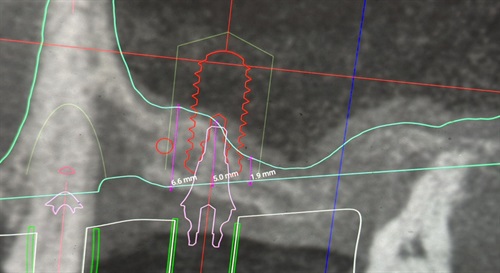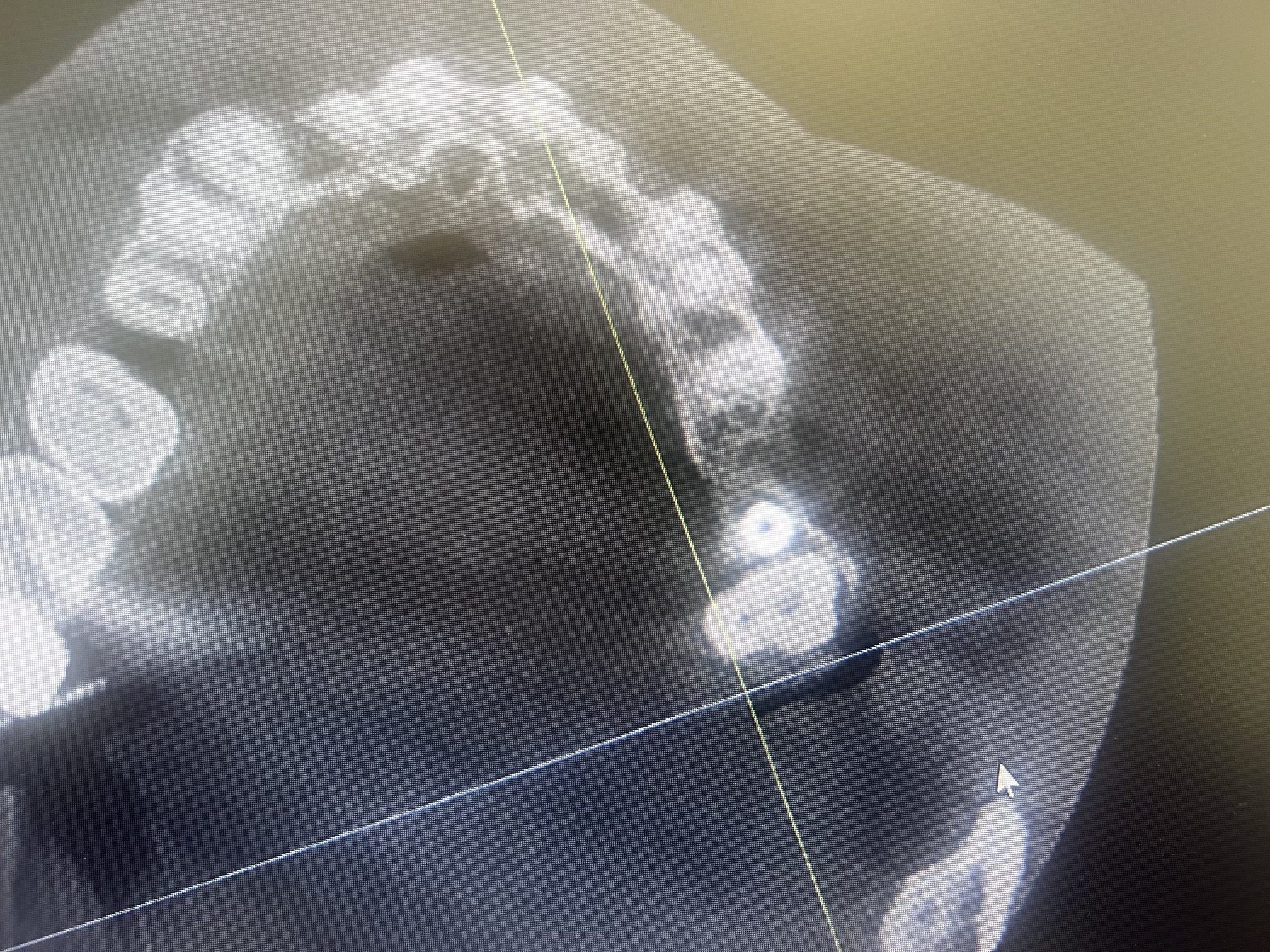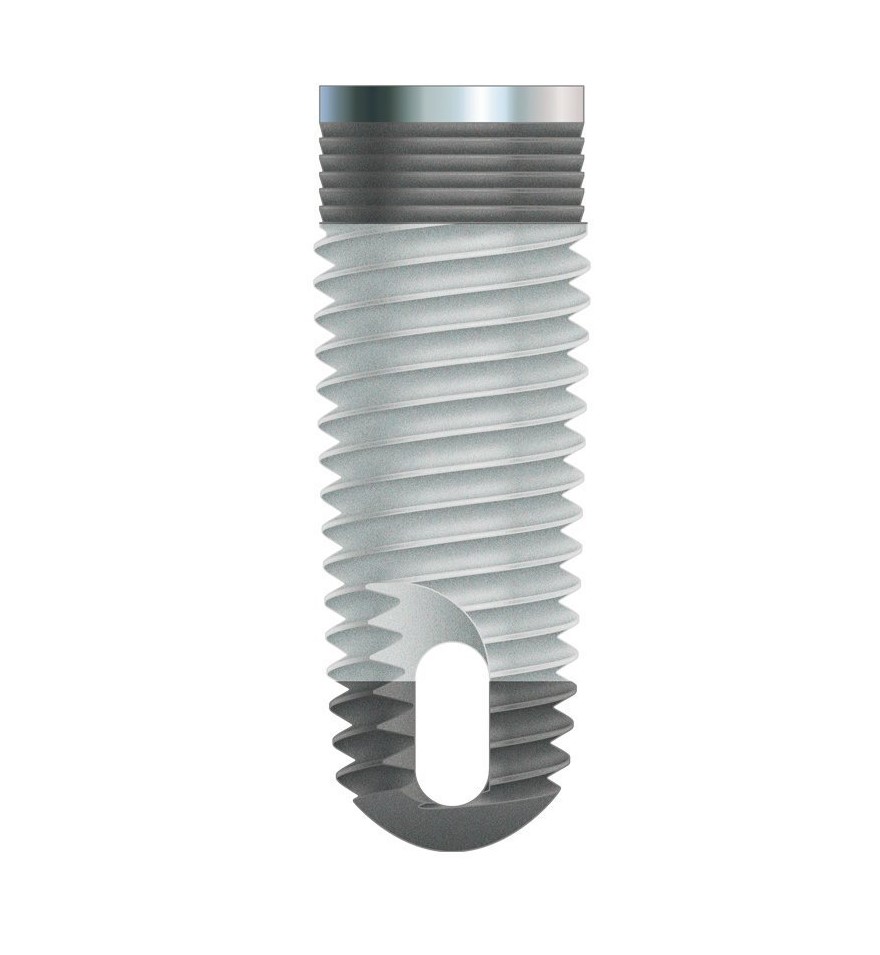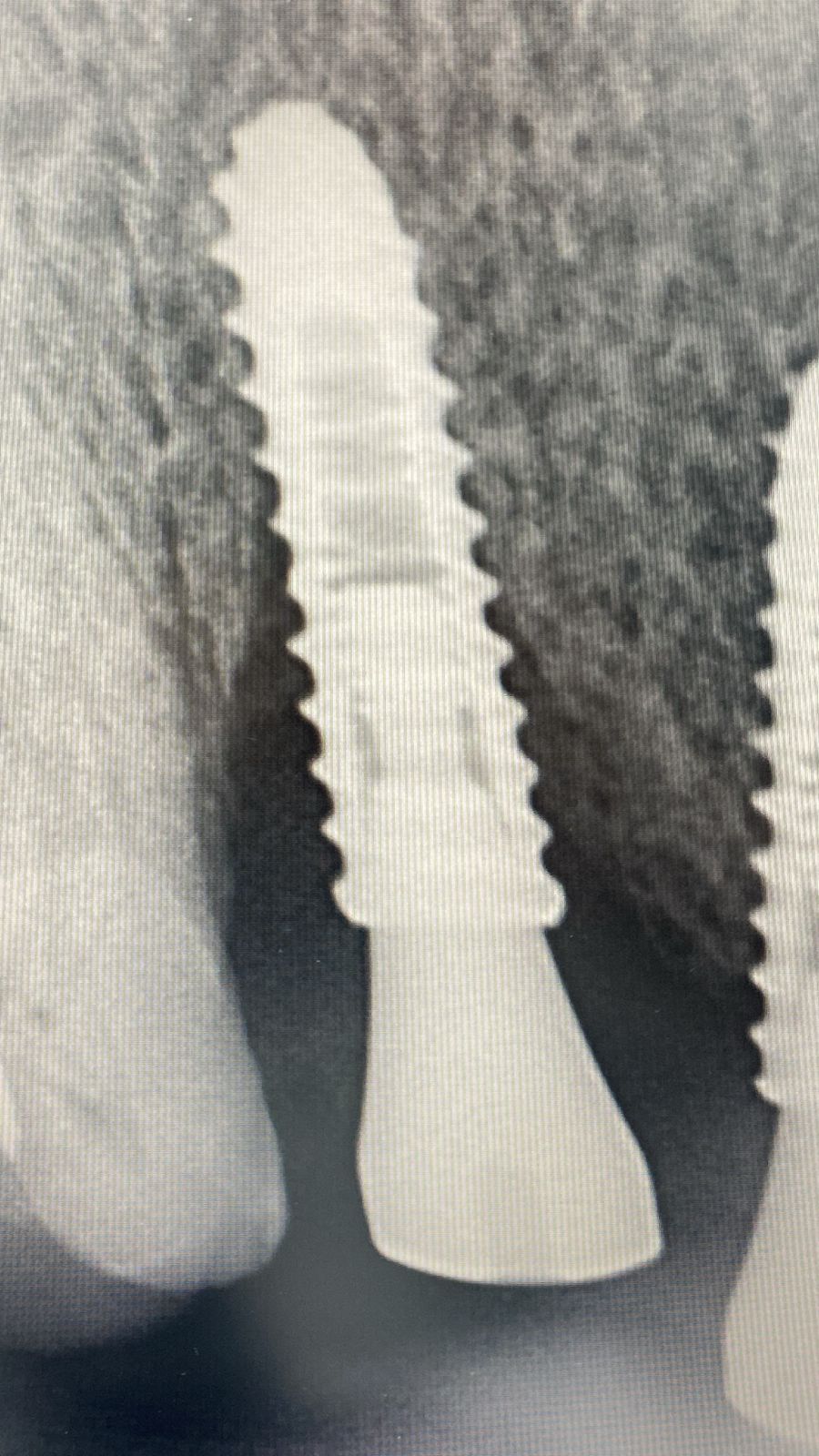Does #10 implant need to be replaced?
Implant at site #10 [maxillary left lateral incisor; 22] was placed in 2007. In March 2013, the implant became infected and was treated with amoxillin. The implant was also infected in 2008, about one week before crowns were placed. Pain is currently still present at implant site despite treatment with antibiotic. Any thoughts on whether implant needs to be done again?



33 Comments on Does #10 implant need to be replaced?
New comments are currently closed for this post.
Leal
4/24/2013
Looking at the CT the implant clearly wasn't placed respecting the minimum buccal ridge. At the time it became infected the buzz should have rang and warned something wasn't right. Now it's buzzing again and the patient feels pain. You say "despite treatment with antibiotic". What does that mean? Does it mean you were expecting the problem to go away with antib.?
What needs to be done is remove implant. Curette. Graft. Wait. Replace implant. Temporize.
What YOU need to do is: refer.
Good luck
OMS Resident
4/24/2013
"Pain is currently still present at implant site despite treatment with antibiotic." Hmm.. In my world analgesics (or even anticonvulsants) would be a more appropriate way to treat the pain (infection set aside)...
Have you considered neuropathy as a possibility (eg. persisting peripheral pain)?
Michael Karges
4/24/2013
Check the chronology of your posting. The implant was placed(vertically) in 2007. It became infected in 2013, and again in 2008?
This implant is clearly not in alignment with the alveolar bone, resulting in a large labial perforation. All of the antibiotics in the world are not going to resolve an ongoing contaminated site until the cause is eliminated, which answers your question--- YES!, this implant needs to be removed.The infection and pain will disappear very soon. In my opinion,the area should be allowed to heal thoroughly,grafted with membrane protection, and in 4 mos. a new, properly aligned implant placed into the alveolar ridge.
CRS
4/24/2013
I agree with Leal, the implant is not in the alveolar housing. Is it mobile? This is when you typically see the breakdown 5-8 years. I am also suspicious of the occlusion the lower tooth seems flared class II with posterior collapse? It is a tough call at placement do you place and graft the dehiscence vs starting over? I think at this point you need to remove and start over, this may be hard to salvage, you could try but it might be best to refer. Two infections and pain probably indicates starting over. It is appropriate to expect pain to subside with an antibiotic usually I like to help it with an analgesic. The comment about an anticonvulsant or neuropathy is just bizarre. We can all get burned on labial plate, can't see it on a conventional post op film or with a flapless placement. It is also a judgement call to graft the surgical dehiscence . This was either a missed dehiscence at placement and/or the angled placement to correct the occlusion. The follow up was appropriate, I'd start over.
OMS Resident
4/24/2013
CRS - forget about a misaligned implant for a sec.. Don't be so harsh! I'm just trying to think outside the box. I've read far more bizzare things on this forum than my comment.
Neuropathy after a surgical procedure (eg. exodontia, implant placement) is not that uncommon, but commonly overseen. Gabapentin and pregabalin = anticonvulsants and commonly used to treat neuropathic pain. You as a maxfac should know this...
CRS
4/24/2013
Maybe oral surgery has changed since I was a resident but typically in my experience a neuropathy will develop near a larger nerve trunk or shortly after trauma not usually in this particular area or 5 years down the line. Actually I have not had much experience with surgical neuropathies after dental extractions or implant placements so I consider myself lucky. In this particular case this would be called a zebra diagnosis when you hear horses hooves. The poster is confused enough figuring out a malposed implant and the sequela that followed so I think it is better to keep him in the box! Maybe residents are more sensitive now-a-days, we used to get hit a lot by the attendings! No harm intended and no OMS were harmed in the development of this post! Thank you for reading!
Marc
4/24/2013
Could someone tell me , with science why it matters that the implant be fully surrounded by bone. Other than anectodes or that it doesn't look good on cbct. Also , other than pain , is there pus ? Redness ? Swelling ? If there is pus where is it exiting from?
Evidence based implantolo
5/1/2013
Hey Marc
What are you doing asking a sensible non-aggressive question like that? Of course it needs to be surrounded by bone, otherwise.......emm well, there would be no point in grafting and nobody could be arrogant about and high-handed.
Wait a minute though the head of an implant isn't surrounded by bone and its in the dirty old mouth and OK. Some implants pass right through the sinus to engage bone and they aren't surrounded by bone.
Ah but if you go on " a course" where you're told they should be surrounded by bone (sponsored by Geistlich no doubt) you can be sure its 100% - That's Why.
CRS
5/1/2013
Actually you bring up a couple of valid points, a trans-sinus implant does pass thru air but the ends are engaged in solid bone and the implant is placed so that the ciliary movement of the sinus membrane is not affected so the body tolerates it. This implant probably had labial perforation at placement but the body tolerated it for five years. The head of the implants in the "dirty old mouth" have an epithelial attachment which keeps bacteria from the implant body. Bone plates are routinely placed in the maxillary sinus during orthognathic surgery and fractures and are only removed if there are symptoms which is rare. When one is experienced with working with the facial bones this makes sense, however it would probably be easier for you to follow the surgical guidelines used in placing implants and you will not get into trouble, I know I respect this. But interesting comment even though it ignores the fact that his implant has symptoms and needs to go.
Sam Jain
4/25/2013
A Picture of the site ia needed and a good pa is needed to assess the interproximal bone
Facial bone is present at the crest where it is the most important. So if prox bone is good the infection is not at the neck of the implant.
So if the apical buccal is infected and red, make a horizontal incision just apical to MG junction, expose the threads and grind them away with a diamond bur all the way to body of implant , this will remove infected titanium, scub with metro clinda tetracycline until your heart content, mi
make taco salad of bmp soaked collagen with mfdba +autogen bone from max tubrosity and graft ( one xxs bmp bottle would be enough)
I also add prf liquid and prf membrane over the graft and close gently with vicryl or gut.
Crestal buccal bone is the best thing going on for u.
Call me if you need help. Enjoy
510 574 0496
Center for implant dentistry
Greater San Francisco-bay area
CRS
5/3/2013
I would advise just for the sake of argument that it is not wise to place an incision over an infected site with no bone support over the area and grind way and place a graft. The would will most likely break down this is surgery101. This is not a periapical infection over a natural tooth and this is very poor advice. The implant surface does need to be detoxified and chemical or laser is a better choice. The flap has to be a full thickness from the crest with a decent wide base not a "taco" at best this is a risky intervention based on the past infections and poor placement. I would definitely advise you to refer this to someone with more experience and understanding of surgical flaps The patient needs to understand hat removal and starting over may be the best course but it is again a judgement call made at surgery in experienced hands. It is not wise to use BMP in this chronically infected site and the additional swelling will also cause the poorly developed flap as suggested to break down. In the future the best course is to avoid this with correct placement with adequate labial plate thru grafting, now you are behind the eight ball. What I'll save you is that this happened 5 years down the line nd you can call it a revision. What needs to be learned is that the initial infection needed to be investigated. Trying to fix this with your skill set or another general dds is not wise based on the comments posted, no matter how many implants they have placed or for how long or what they call their implant center or practice. I know this is an unpopular opinion but when you get into trouble appropriate referral is indicated, sometimes I feel that honest straightforward advice in spite of bruising egos in indicated. I hope that is the reason why this was posted and I sincerely hope you will take my advice. Good Luck and learn from this. Thanks for reading.
naser
4/25/2013
there is labial perforation , if you press by fingers on the labial mucosa you will see the black shadow of the implant through the mucosa , this implant is to be removed and the site disinfected and redo.no need for any medication
Richard Hughes, DDS, FAAI
4/25/2013
Grafting may cause an esthetic issue with the lip drape. So removal appears to be the solution and grafting the site for future placement. Block and Kent's text discuss neuropathy well after placement.
CRS
4/25/2013
Ok, I in my opinion this is a case where an implant was incorrectly placed outside of the alveolar housing and two post operative infections developed and now the patient has pain. I think those facts can be agreed upon even though to some it may sound harsh. In my opinion, anticonvulsants won't fix that. Dental implants usually do best when covered by bone otherwise why do we take such pains to accomplish this. Lip drape will not be affected by adding 2-3mm of labial bone and a vestibuloplasty corrects that anyway since this is mobile tissue. Opening the area up a decision will be made to graft or remove, I would speculate that removal would be the best option, regrafting and placing the implant in the correct spot, in between th cortical plates. I feel that sometimes however painful to the ego, one has to admit a mistake and start over to fix it. Yes we all make mistakes. Sometimes it is just easier to keep it simple instead of interjecting how smart we are will every possible means to fix this. A graft would be taking a chance due to the infection history and grinding away threads within the bone may heat up the bone, be difficult to remove the metal shards and in my humble opinion, heroic. If it is a neuropathy wouldn't it make sense to remove the cause? Call it a revision of a failed implant remove it and move on, I think that is practical advice vs theory. Again thanks for reading
Sam Jain DMD
4/26/2013
The two adjacent root prominences make a nice concave anatomy and grinding the implant will make it further concave. Bone grafting the exposed implant should be the first line of treatment. Less invasive, less traumatic, no essix, no flipper, less expensive and more predictable then extracting the implant. More practical.
Richard Hughes, DDS, FAAI
4/26/2013
I doubt if it is a neuropathy. If it is, removal may make it worse.
Gregori M. Kurtzman, DDS,
4/30/2013
The implant was placed not following the contour (triangle) of bone and is too vertical for the maxillary anterior. That is what started the problems off. No matter what graft you place on the facial the pull of the lips will cause the graft to resorb over time as the anatomy was not followed at placement.
It appears that the implant was place following the root that was present which also was too vertical and thus failing due to perio. the implant should have been placed at more of an angle to get it completely in the bone (some grafting may have been needed at placement on the facial or the site grafted after extraction before an implant could be placed). At this stage the best tx IMHO is removal of the implant grafting the site and then after 3 months place a new implant. I am cautious to place a new implant in the site at time the old implant is removed due to the bone that will be lost in removing the old implant and the hx of infections in this area.
Sam Jain DMD
5/1/2013
I think there is too little info, we do not have a complete picture. The poster is passive.
Decision will be based on a number of things. Let's not waste our time.
Dr G
4/30/2013
Undoubtedly after thousands of implants placed I've created this exact same scenario. With that said I don't see symptoms all that often. Have you tried to flap this and take a look? I'm guessing the clinical picture is a thin mucosal margin, thus there is calculus in the threads all the way up the facial. How about remove crown, add cover screw, flap, disinfect, etch, graft, membrane. Submerge the implant and when you replace the crown add KG if its thin. Any thoughts Dr's? I'm just concerned what the ridge will look like if we trephine out this existing implant from an already thin ridge.
Gregori Kurtzman, DDS, MA
4/30/2013
I think the implant can be removed by placing a placement head in the implant after removal of the crown and abutment and counter rotating it to break the integration on the palatal in the soft bone of the maxilla it can be done easily without the need to trephine in most caes
Richard Hughes, DDS, FAAI
5/2/2013
Dr G, I agree with you. Flap, look, clean the implant, perhaps smooth down the exposed threads, place OsteoTape over the implant, close and let nature do the rest.
As a side note the American Academy of Implant Prosthodontics and the International Academy of Implants and Transplants will meet in Carefree, Ax on Oct 4 and 5 this year.
k
4/30/2013
I'm so glad I read this. While it is pretty obvious this implant needs to be removed and the site rebuilt prior to any further implantation I have really enjoyed the comments about anticonvulsants and neuropathy. It's been a long time since I've heard someone so off base as to the cause of a problem but still can argue something that presents with pain.
Maybe lower posterior
Dr. Numier
5/1/2013
you the man
Zeerak Samuel
5/1/2013
I agree with Dr.G.
Its a conservative approach and might work very well. Id be prepared to remove the implant only if prognosis looks bleak after flap elevation.
Good luck.
T. Giorno
5/1/2013
Be prepared to remove the implant, but to be sure 100% you have to:
1- open the flap.
2- if some of the implant is exposed in the buccal concavity, remove it. There is no way you will achieve long term re-attachement to the bone because the implant surface has been altered....
3- Eventually, if the site is clear, (prior Antibiotherapy), you might place another stable implant, and graft the buccal. Biomat of your choice, covered with L-PRF membrane)
4- Do not load the implant for 3 to 5 months.
You should then have success.
E Mellati
5/2/2013
The first step which seems to have received the least attention is to figure out where the pain is originating from? Is the implant mobile or tender to percussion? Is the pain spontaneous? Is there any abcess present?
The information you provided is not enough. Post a periapical film and also a clinical photo to see how the soft tissues look like. Although not ideal, having a buccal fenestration is not necessarily a failure. Many implants are surviving well with fenestrations and dehiscences of buccal plate as long coronal biologic seal can be maintained by proper periodontal maintenace. Get a perio probe and probe around the implant to see if there's any deep pocketing, BOP and/or suppuration. Also check the restoration and ensure it's integrity. I wouls also check the occlusion for any excessive guidance in latrusive and protrusive movements. Looks like it's a cemented restoration rather than screw retained. Peri-implantitis is more common with cemented ones.
Gregg Weinstein
5/3/2013
without too much explanation look a the cone beam. remove that fixture and graft. second row right shot. A graft might work for a few months until the bone resorbs to maximum surrounding width.
Richard Hughes, DDS, FAAI
5/4/2013
One could proceed either way with this case. Flap and clean and recontour or remove and graft. CRS is correct about flap design. Basic surgical principles have to be followed
Susan a
5/4/2013
Implants should be surrounded by bone, but aren't always, as we know. We also know that implants should not be infected and certainly not over and over. If you are not a surgeon, refer this. Removal is probably necessary because of poor placement.
CRS
5/4/2013
These are all excellent ideas since routine post op films don't show buccal plate and many perforations will heal. It is often difficult o remove an implant with this placement since the buccal bridge of labial plate could be destroyed. If it were me, I would flap the tissue full thickness, see if I could salvage it with grafting if it was not mobile. I would prefer to remove it if I could do so without causing more damage. I would strongly advise the patient of the guarded prognosis and the need for future removal and more grafting etc. I love to be judgmental about placement but honestly It is 20:20 hindsight. So good luck but get some help especially since you want to remember to do no harm! Thank you for reading .
Dr M C
5/7/2013
Hi Doc, in my opinion, reflect flap and trim of excess implant , graft and close.
Sam Jain DMD
5/8/2013
If you are into Perio flaps/ Perio finesse, worrying about papilla and facial recession around implants and if you are into tunneling and micro surgery and have seen the work of Dr Dennis Shenlac, you will not lift gingiva from the neck of the implant or raise a full thickness periosteal flap, especially when the buccal crestal bone us not a lot,
So u would make a horizontal incision apical to mucogingival junction to reach the implant to trim it and graft. I would not
Promise
perioprosth doc.
5/22/2013
Before you take action to remove the ailing implant, please understand explantation of an implant in the esthetic zone can potentially be complicated to treat and if you fail to regenerate adequate bone & soft tissue the consequence would be even worth. if you are not trained to do GBR and CT graft, refer for the surgical phase and continue with the restorative phase.
good luck.
















